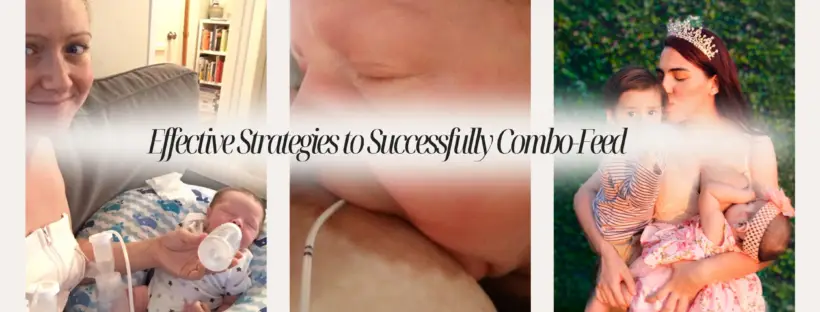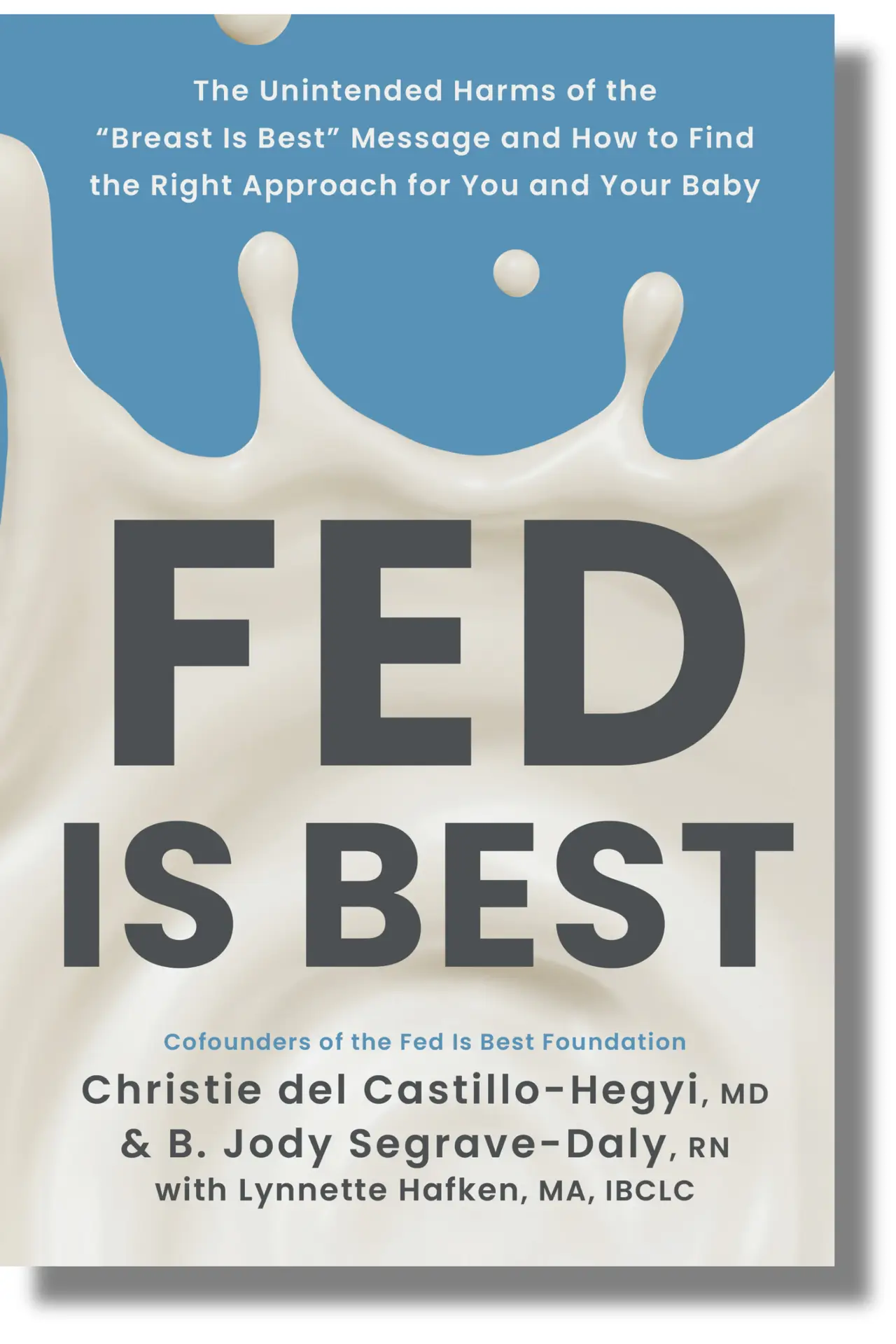Did you know combo-feeding is the most common way to feed babies worldwide? In the US, 75% of babies and 59% globally receive infant formula during the first year of life, yet it is often overlooked in new parents’ infant feeding education and support. Given these significant statistics, parents shouldn’t have to navigate alone or rely on friends, family, and social media for potentially inaccurate information that could compromise the health of infants or breastfeeding itself. Continue reading
Tag: Breastfeeding
The Fed Is Best Book: Protecting Infants and Empowering Choices

Sandra Stephany Lozoya combo-feeding her babies
In a world filled with parenting advice and conflicting messages, there emerges a beacon of wisdom and support – the upcoming release of the Fed Is Best book. Set to hit the shelves June 25, 2024, this transformative guide promises to navigate the intricate landscape of infant feeding choices, empowering parents with knowledge and judgment-free support. This highly anticipated book will reshape the conversation around infant nutrition, offering a comprehensive, science-backed, and inclusive perspective on the myriad ways families can safely and optimally nourish their babies.
What is the difference between this book and so many other breastfeeding manuals? The goal of the book is not to convince to feed your baby in one way or discourage you from feeding another by painting one type of feeding as ideal and the other as suboptimal or undesirable. The goal is to help you find the best way to feed your baby that fits your biology, your ability to produce milk, your baby’s needs, and the many social, economic, psychological, and practical factors that define what “best” infant feeding looks like for your family–which is different for every single family.
For too long, parents have had to accept a monolithic message that only exclusive breastfeeding provides the best for their infants. Mothers have been told that if they “perceive” that their milk is not enough, they are likely mistaken, under-educated, doing it wrong, or simply not trying hard enough. Little do they know that scientific research has shown that when measured by objective means, true insufficient milk supply is actually quite common. As a result, the message that insufficient milk is rare and supplementation is rarely necessary is putting many infants at risk and many mothers at risk postpartum mental health problems due to the faulty message that low milk supply is their fault. Little do parents know that health professionals have been witnessing a rise in complications of insufficient feeding of exclusively breastfed infants, like jaundice, dehydration, hypoglycemia, and failure to thrive, for as long as parents have been receiving this message. And the most common victims are those who have diligently followed the guidelines they have found in parenting and breastfeeding manuals yet found that their milk supply was truly too low to safely exclusively breastfeed.
This comprehensive and compassionate guide gives you the raw truth of about breastfeeding and formula feeding, dissects the history and science of breast- and bottle-feeding, and helps you prepare to reach your feeding goals in a safe and practical way. It does this by teaching you how to be flexible and respond to problems while working towards your goal, whether it be exclusive breastfeeding, exclusive formula feeding, or combination feeding.
This groundbreaking work is divided into two distinct parts, each addressing crucial aspects of infant feeding.
Part 1: The History and Science of Infant Feeding
The first section of the book lays a solid foundation by exploring the complex history and science behind infant feeding practices. It starts with Chapter 1, delving into the evolution of breastfeeding, the role of supplemental feeding, and the development of infant formula, providing readers with a broad context to understand how current practices came to be.
In Chapter 2, the book challenges prevalent beliefs surrounding breastfeeding, debunking harmful myths and shedding light on inconvenient truths that often go unspoken in the discourse on infant nutrition. This chapter aims to foster a more nuanced understanding and encourage critical thinking about the information often presented to new parents.
Chapter 3 addresses the polarizing debate between breastfeeding and formula feeding, questioning the notion of a singular “best” method of infant feeding. It presents evidence-based insights that highlight the benefits and considerations of each method, promoting a balanced view that respects individual circumstances and needs.
The final chapter of this section, Chapter 4 defines optimal infant feeding through a scientific lens, arguing why “Fed Is Best” is a principle that supports the health and well-being of all infants, regardless of the feeding method chosen by their families.
Part 2: The Fed Is Best Guide to Safe and Optimal Infant Feeding
Transitioning from the why to the how, the second part of the book serves as a practical guide for expectant and new parents. Chapter 5 discusses preparations before birth to ensure that parents are equipped with the knowledge and resources needed for optimal infant feeding from day one.
Chapter 6 focuses on the critical first few days of an infant’s life, offering guidance on how to protect against insufficient feeding and ensure that newborns receive adequate nutrition for a healthy start.
Subsequent chapters delve into the specifics of various feeding methods. Chapter 7 through Chapter 11 cover breastfeeding, pumped milk feeding, formula feeding, combination feeding, and bottle feeding, each chapter providing detailed advice, troubleshooting tips, and support for the respective feeding method. The book emphasizes the importance of honoring and supporting all families and their chosen safe infant feeding practices in Chapter 12, advocating for a non-judgmental and inclusive approach to infant nutrition.
The “Fed Is Best” book promises to be an essential resource for parents, caregivers, and healthcare professionals alike, promoting a more informed, compassionate, and inclusive approach to infant feeding. By combining historical context, scientific evidence, and practical guidance, this book aims to empower families to make informed decisions that best suit their needs and circumstances, ensuring that every infant is fed with love and care. Click the button below to pre-order your copy.
How Breastfeeding Coercion Stripped this Psychiatrist of Her Confidence and Mental Health
By Michelle M., Psychiatrist, MD, and First-Time Mother
It’s taken me a long time to really have the strength to talk about this, but I think it’s time.
I’m a 40-year-old, first time mom to an amazing 9-month-old son. Throughout my pregnancy I was repeatedly asked if I would breastfeed and received endless lectures on the benefits. I was honestly skeptical about the claimed breastfeeding benefits… (liquid gold? seriously?), but continued to answer “yes”, as it felt like saying “no” would be the wrong answer.
I figured I would try, and if it worked, great! If it didn’t, then formula was “Plan B”. I really didn’t think much of it, and figured the baby would get fed one way or another.
Fast forward to my 37th week of pregnancy. My water broke with no warning, and I had an awful labor due to a failed epidural and uterine tachysystole. Then to top it all off, I had an emergency c-section when my baby’s heart rate disappeared from the monitors. Labor and delivery didn’t go exactly as planned, but I was elated when it was over, and I had my beautiful baby.
The Illusion of Choice: Baby Friendly USA Says Newborns “Should” Room In With Their Mothers
by Jody Segrave-Daly, Veteran NICU/Nursery nurse, IBCLC retired and Cofounder of the Fed Is Best Foundation
The standard of care for most hospitals, especially those who are Baby-Friendly certified, is that mothers stay with their baby after birth in their room, 24 hours a day, which is known as rooming-in.
Baby Friendly’s recent blog says that mothers have choices about nursery care in their Baby-Friendly certified hospitals; but then they say babies SHOULD stay in the room, no matter how they are being fed. This statement gives parents mixed messages and implies they don’t really have a choice at all. In many hospitals, it is not just implied; nurseries have been eliminated outright.
“Regardless of whether a mother is breastfeeding or formula feeding, they should room-in with their newborn.”
According to the World Health Organization, rooming in began as a way to promote early breastfeeding and to encourage bonding. Step 7 of the Ten Steps to Successful Breastfeeding calls for hospitals to “enable mothers and their infants to remain together and to practice rooming-in 24 hours a day.”
Despite the WHO’s 2017 expert panel’s finding that 24/7 rooming-in was ineffective at promoting sustained breastfeeding after discharge (but recommended it any way) and published tragedies of harmed infants while rooming-in, The World Health Organization and UNICEF continue to include rooming in for healthy newborns in the Ten Steps to Successful Breastfeeding policy.
Since adopting the rooming-in policy, inexcusable consequences such newborn falls from parent beds and near deaths and deaths from accidental suffocation while breastfeeding or doing skin-to-skin care (known as Sudden Unexpected Postnatal Collapse or SUPC) have skyrocketed, highlighting the urgent need for families to have access to nursery care.
“Parenting Classes Need to Discuss Other Feeding Options, Not Just Breastfeeding”
Hello,
I saw on your website that you guys are encouraging parents to share their feeding journey and I thought I would share mine.
My baby was born March 6, 2021, after 48 hours of labor which resulted in a c-section, just shy of 39 weeks gestation. She was 6 pounds 3 ounces and healthy as can be. My plan was always to breastfeed, so the lactation consultants (LCs) in the hospital helped me right away with latching. We discovered a tongue tie and that was corrected when we left the hospital.





